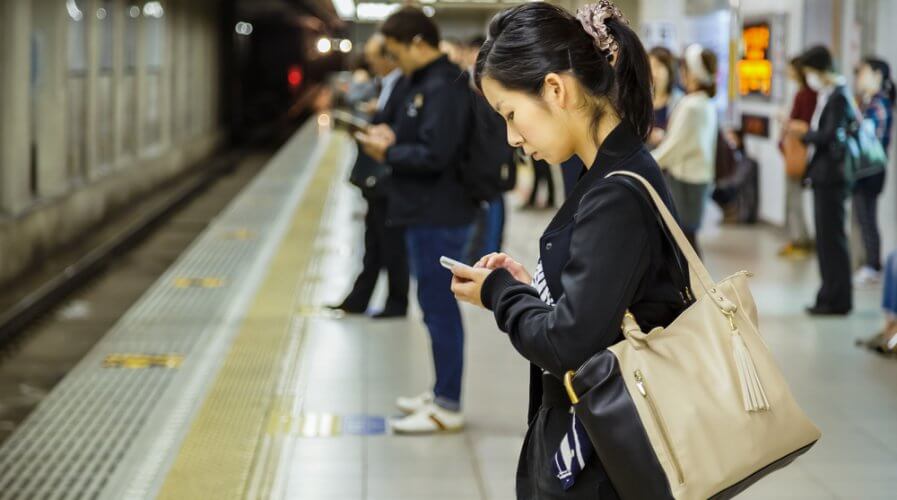
Lock screen advertising is becoming a big deal in the digital world. Source: Shutterstock
Buzzvil CSO explains how businesses gain from lock screen advertising
THERE are about 2.71 billion smartphone users worldwide. The average user unlocks their phone up to 60 times a day and spends up to 4 hours on the device.
Of course, when using the device, most spend their time on social media, chat, and gaming apps — which means that’s where digital marketers should spend their ad budgets. But the reality is that users are increasingly turning a blind eye to search and display ads on platforms such as Google and Facebook.
It’s why lock screen advertising is picking up so quickly — in South Korea and across the world.
Lock screen advertising giant Buzzvil has captured their domestic market and claims to be raking in up to US$3.2 million per month — which translates to a cool US$38.4 million per annum before taxes.
In comparison to Google and Facebook, they’re definitely a small player, but the company is making great progress outside South Korea with hopes to make a debut in other markets across the region very soon.
Buzzvil Chief Strategy Officer Joshua Kwon spoke to Tech Wire Asia to provide some insights on what lock screen advertising is and what it helps advertisers — businesses and brands — achieve overall.
“Users pick up their phones up to 60 times a day, which means, they see their locked screens up to 60 times a day. That’s an opportunity for us to captivate our audience and flash them an ad. Since we’re non-intrusive, our ad makes an impression that positively influences brand recall.”
In a nutshell, that’s what lock screen advertising is — an ad on your phone’s lock screen.
There’s magic when you bring reward ads into the frame
Reward ads are ads that are played to users in exchange for something of value, such as virtual currency, in-app items, exclusive content, or maybe just free data.
“Click-through rates (CTR) on average ads, lock screen or otherwise, is between 0.1 percent and 0.5 percent. With rewards added in, the average CTR rate can go up to 20 percent.”
Buzzvil leverages reward ads on lock screens to wow customers and delight advertisers.
Kwon points out his company caters to every major e-commerce brand in his home market — all of whom are returning customers, spending more than US$100,000 on the lock screen advertising platform every month.
Outside South Korea, Buzzvil supports large US and Japanese brands who come to the platform to gain recognition among local audiences.
To be fair, reward ads are possible to be incorporated on other platforms such as Facebook and Google, however, Kwon claims that they’re usually most effective on lock screen formats.
Here’s why businesses should give lock screen advertising a thought
“Lock screen advertising is slowly becoming a key tool in the arsenal of forward-thinking digital marketers.”
According to Kwon, after allocating reasonable chunks of the digital marketing budget to ads on Google and Facebook, e-commerce platforms that work with Buzzvil prefer to put in a sizeable chunk of the budget into lock screen advertising.
“Digital marketers, of course, do what they know brings them results, and their return to lock screen advertising is proof that there’s plenty of value in this space for them.”
Kwon suggests that more businesses should think about lock screen advertising with an open mind — including reward ads.
An interesting idea that Kwon touched upon during the interview was that telcos in Asia are in a position to really harness the power of lock screen advertising as they own the infrastructure and can provide rewards such as additional data for social media or gaming in exchange for a strong captive audience waiting to be marketed to.
According to the Buzzvil’s Chief Strategy Officer, telcos are aware of this opportunity and he expects them to act on it soon, making headlines, and delighting customers and businesses across the board.
Overall, however, Kwon feels lock screen advertising is a niche market that needs more attention — simply because it can give businesses more mileage when it comes to advertising in a very cluttered market.
READ MORE
- Ethical AI: The renewed importance of safeguarding data and customer privacy in Generative AI applications
- How Japan balances AI-driven opportunities with cybersecurity needs
- Deploying SASE: Benchmarking your approach
- Insurance everywhere all at once: the digital transformation of the APAC insurance industry
- Google parent Alphabet eyes HubSpot: A potential acquisition shaping the future of CRM








